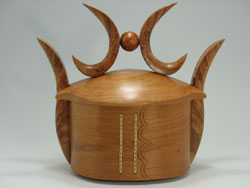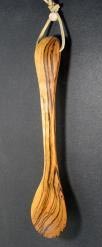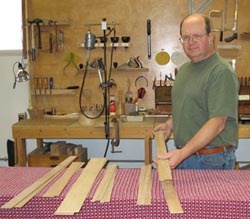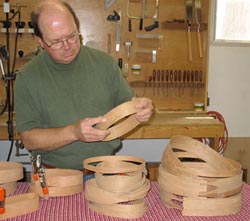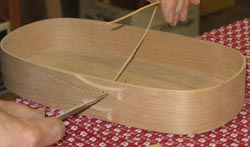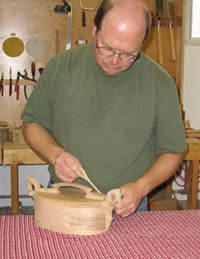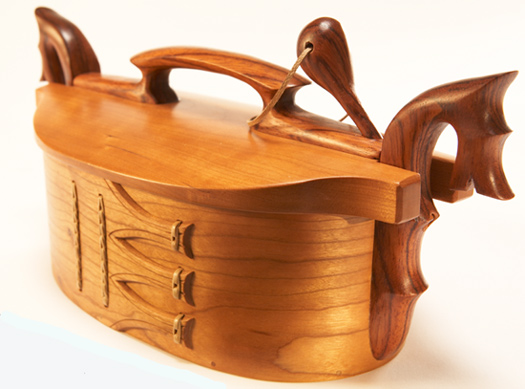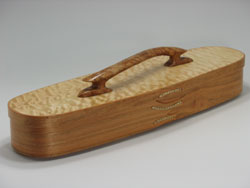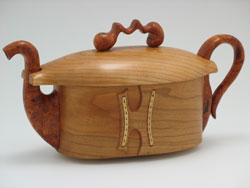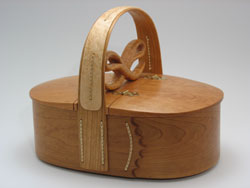
“I’ve been working wood since I was old enough to wield a hammer,” Jim Anderson told me when I asked him how he got involved in making his unusual looking bentwood boxes. “My father worked in housing, so I always had access to scrap wood from housing sites.
“After high school, I did a few odd jobs, went into the Navy, then came out four years later and went to work for a company that built computer products. It was what was available, and I stayed there 24 years, but I always did woodworking as a hobby, doing everything from turning and carving to furniture.
“About 20 years ago, I started building Shaker boxes just as my company started to downsize. I could see the handwriting on the wall, so even before I got laid off I decided to try to make a living at my first love, woodworking. I went to art fairs to see what was selling, and decided there was more market for Shaker boxes than there was supply, at least here in the Midwest. They are much more common on the East Coast, but not so much here.
“I decided to have a show in my own home. We invited about a hundred friends and family to show bentwood products, and used the show to figure out what people liked. They bought quite a bit from me. The next year I started applying to art fairs, and was pretty successful. I found I could sell everything I could make doing eight or 10 art fairs per year. I also added carved spoons, though I see them as strictly an adjunct to my main line of work.
“About four or five years later, when I was trying to get into really high quality juried art fairs, I realized that the Shaker boxes were too simple to impress the judges. I had become aware of Scandinavian style boxes, which are much more ornate and less restrictive in terms of design. I started making them and sending them to the juries, and found I could get into better shows and make more money with that style box. Of course, they are also more labor-intensive, but it was successful enough that I decided to focus on them. With them, I’ve taken awards at a number of art fairs, even in ones with very tough competition. One of my boxes is in the Vesterheim Norwegian-American Museum.
“As far back as the days of the Vikings, Norwegian and other Scandinavian craftsmen found that by cutting thin bands of wood and soaking them in hot water, they could bend them around a form. After drying, these bands were laced together to form the body of a box that was both strong and lightweight. Tops and bottoms were added in many different styles to suit the needs of the family. These boxes, called ‘Tine’ (pronounced tee-nah, which means ‘box’ in Norwegian), came to America with the early immigrants.
“I start the box making process by cutting thin bands of wood on my table saw. They get soaked in boiling water for about 10 minutes, then a band gets bent around a form. I leave them clamped for three days until they are dry, and glue them together. In the old days, they would use roots to stitch them. Although it is strictly ornamental, I do the same using cane lacing strips. The bottom is actually veneered MDF rather than solid because the banded sides won’t give, and larger ones can expand enough blow apart. The tops, though, are solid, since they are not captured to the sides, they can move without damaging the box.”
“Finally, I add a removable locking pin on one side and a fixed pin on the other. By removing the locking pin, you can slide the lid out from the other pin and take it off entirely. On boxes with no visible pins, the hidden pins are smaller. To open the box, you must push on the horse head, which gives a bit, to release the lid.”
Perhaps the most iconic of his boxes is what he, and his customers, call a dragon head box, but Jim was quick to inform me that the carvings are not what most people think. “Those are not actually dragons,” Jim explained, “but rather are depictions of the Norwegian Fjord Horse, a type of horse that is common in Scandinavian countries. It is a very distinctive looking horse that is smaller than American horses. I call the boxes ‘dragon boxes’ because that is what most people think of when they see them.”
“Not all my boxes are strictly traditional. Somewhat of a departure from the typical style is the Nordic pipe box I made as a custom order. A customer inherited a very decorative Norwegian smoking pipe from the 1800’s. He wanted a custom box to store it, and I designed the box to fit. I made two so he had his choice; the one on my website is the one he did not choose. It’s 22 inches long and six inches wide.
“The teapot is another departure from tradition. I have always been interested in pottery as well as woodworking. Potters get to make teapots; I felt woodworkers should be able to as well. Naturally, the wood ones are decorative, but people do use them to store tea bags in. Others went to teapot collectors. They do sell rather well.”
Clearly, though, it is the pleasure in what he does that keeps Jim at it. “I enjoy making decorative things,” he told me, “and if I can make a living at it, so much the better. Granted, although it is a very enjoyable lifestyle, it is not a rich one. I could probably be making more money stocking shelves in a grocery store, but I wouldn’t have near as much fun.
“I try to make things that will be lasting family heirlooms, and I think that is what people want. It’s something you can be proud of owning, and might just increase in value. At least I hope so.”
